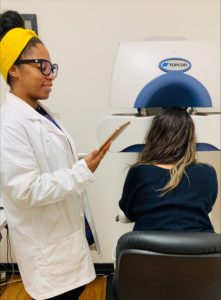

She works in the office to see patients in person and also uses a variety of telemedicine tools to help her assess or monitor others. “My idea was to come up with a hybrid practice where I am in the office three days a week and offer remote services two days a week. Today, there is great instrumentations that allows us to do that,” she says. She has made Saturdays an in-person day, making it easy for patients who would like to be seen in person.


Her imaging system includes in a smart phone attachment so she can capture images. She uploads images into a cloud-based system so she can view them remotely, and she has a camera on a tripod in the exam lane so she is present virtually on the days she is not there.
“NOT EVERYONE IS A CANDIDATE”
Dr. Evans notes that it is important to note that not every patient is a candidate for a telemedicine visit. “I had to train the staff to triage. If someone is experiencing any pain or red eye, that needs to be scheduled for a day when a doctor is there. Same with any child under 7. I’m there for all patients who need retinoscopy or a dilation,” she says.
Sometimes that means having a patient return. For example, if the retinal images show concerns about glaucoma, she says, “We can do the rest of the exam and have that patient come back or refer them based on the strong referral network I have in place.”
While many patients have a sense of what an in-person eye exam consists of, they may be a little more apprehensive or curious about how a telemedicine visit compares. “We have a large-screen TV that plays videos explaining the newest advances in eye care and also what our equipment and testing procedures are. The signage we have says, ‘Virtual exams conducted at this location,’ and that makes people curious. My technician explains that the same tests are done in a virtual visit, if the patient is a good candidate.”
GETTING PAID
Dr. Evans uses a HIPAA-compliant telemedicine platform, with a waiting room function where the patient can view videos while they’re waiting. “It’s an accessible means of allowing patients to have a great and convenience experience,” she says. She also has incorporate, an tablet-based electronic health records system. “It is an EHR, scheduler, text messaging and emailing system with the tablet interface. I can talk with the patient remotely and show them the photos I am seeing,” she says.
“The reception from patients has been tremendous, and many of my colleagues are asking questions,” she says.
Her in-office days are typically 9 a.m. to 6 p.m., with a longer day on Mondays. But now if there are snow days or her toddler is sick, “I don’t have to miss a beat. I’m still able to view the results of the refractions and see the images and issue a prescription,” she says.
Optometry had been slower to the telemedicine adaptation than some other professions, she says. The COVID-19 pandemic pushed forward reimbursements for patients with government-funded health care, and many other insurances followed suit, she says. Today, her telemedicine services are covered by VSP, Spectera and Medicaid in addition to private pay patients. In addition, incorporating telemedicine into her practice has allowed her to be much more efficient with her time.
Dr. Evans is looking for ways to expand her reach. She is licensed in 12 states, so the idea of investing in telemedicine equipment in other locations as permitted under each state law and bringing on an optometrist to work two or three days a week could be an effective way to expand her business footprint.
Finally, finding an alternative way to practice and balance work and home has added renewed enjoyment. “I didn’t think I could have this much fun,” she says. That shows in the way she has approached decorating the practice space. “Our walls are covered in photos; there’s a coffee bar and great music playing. People walk in and are surprised to find this kind of environment,” she says.



